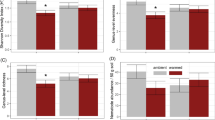Abstract
Spatiotemporal patchiness in the soil environment is thought to be crucial for the maintenance of soil biodiversity. It provides diverse microhabitats (allowing resource partitioning), and presents these in a complex mosaic, such that competitors may be spatially and temporally separated (promoting patch dynamics). The objective of our study was to assess the importance of patch dynamics for the maintenance of landscape-level nematode diversity. The spatiotemporal aggregation patterns in populations of five species of the bacterivorous genus Chronogaster were analyzed for a 0.7-ha riparian wetland, during four seasons, using geostatistical methods (spatiotemporal variograms, cross-correlograms, and log-normal kriging). We found that for the three most abundant species, aggregation was significant over distances of 13–39 m, with intraspecific aggregation stronger than interspecific aggregation. In addition, species patterns appeared to be temporally dynamic: local population declines alternated with local blooms at different sites and seasons. One species was consistently present at the same few sites, but the other species showed gradual temporal decreases and increases at different locations in the wetland. Combining nematode patterns with information on soil resource distributions and Chronogaster ecology, indicated that both soil resource patchiness and repeated, but largely unpredictable, disturbances caused by local soil moisture fluctuations could promote landscape-level Chronogaster diversity by providing ample 'probability refuges.' Local species populations, reduced by competition, predation and drought, could recolonize patches either through the awakening of local dormant 'seed populations,' or through limited passive dispersal by wind, water, and phoresis. We suggest that the spatiotemporal Chronogaster data provide preliminary evidence for the importance of patch dynamics in maintaining soil nematode diversity.
Similar content being viewed by others
Author information
Authors and Affiliations
Additional information
Electronic Publication
Rights and permissions
About this article
Cite this article
Ettema, C., Rathbun, S. & Coleman, D. On spatiotemporal patchiness and the coexistence of five species of Chronogaster (Nematoda: Chronogasteridae) in a riparian wetland. Oecologia 125, 444–452 (2000). https://doi.org/10.1007/s004420000468
Received:
Accepted:
Published:
Issue Date:
DOI: https://doi.org/10.1007/s004420000468




